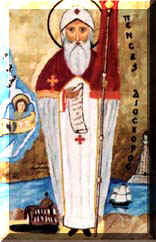Pope Dioscorus I of Alexandria
|
Saint Dioscorus the Great The Champion of Orthodoxy |
|
|---|---|
| 25th Pope of Alexandria & Patriarch of the See of St. Mark | |

Coptic icon of St. Dioscorus
|
|
| Papacy began | 444 |
| Papacy ended | September 454 |
| Predecessor | Cyril "Pillar of Faith" |
| Successor | Timothy II |
| Personal details | |
| Born | Egypt |
| Died | September 454 |
| Buried | Island of Gangra, Paphlagonia |
| Nationality | Egyptian |
| Denomination | Coptic Orthodox Christian |
| Residence | Saint Mark's Church |
| Sainthood | |
| Feast day | 7 Thout in the Coptic Calendar (4 September in the Julian Calendar) (17th September in the Gregorian Calendar [from 1901 to 2099]) |
Pope Dioscorus I of Alexandria, 25th Pope of Alexandria & Patriarch of the See of St. Mark. He was deposed by the Council of Chalcedon in 451 but was recognized as Patriarch by the Coptic Church until his death. He died in the Island of Gangra, Paphlagonia, in September 454. He is venerated as a saint by the Coptic and other Oriental Orthodox churches.
Pope Dioscorus served as the dean of the Catechetical School of Alexandria, and was the personal secretary of Cyril of Alexandria, whom he accompanied to the Council of Ephesus in 431. He eventually rose to the position of archdeacon.
In his struggle against Nestorius, Cyril explained the union between the divine and human natures of Christ as "inward and real without any division, change, or confusion." He rejected the Antiochene theory of "indwelling,", or "conjunction" or "close participation," as insufficient. Thus the Alexandrian formula adopted by Cyril and Dioscorus was "one nature of God the Word Incarnate," which translates into Greek as mia physis tou theou logou sesarkomene, by which Cyril meant "one nature"—that Christ is at once God and man. On the other hand, the Antiochene formula was "two natures after the union," or "in two natures," which translates to dyo physis. This formula explained Christ as existing in two natures, God and man.
Nestorius was condemned and deposed by the First Council of Ephesus, which approved of the Second Epistle of Cyril to Nestorius.
...
Wikipedia
